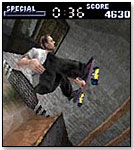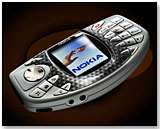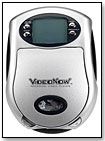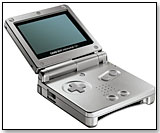|
|
Fun to Go: New Hand-Held Gaming and Video
Zodiac’s a Killer
“Bluetooth creates a social experience,” said Byron Connell, co-founder and VP of marketing for Tapwave. “You can hang out with your buddies at Starbucks playing games.” Given Zodiac’s PDA features and price point, it’s not hard to spot the device’s rival for the 18-34 gamer crowd.
“N-Gage is clearly going after the same market,” said Connell. “But we chose not to converge the [cell phone and gaming] technologies. We saw it as problematic. A phone should be a communication device first. “The problem with cell phone gaming,” he continued, “is that the latency is very bad. If you’re playing a fighting game with someone, by the time you throw a kick—he’s already moved.” Connectivity comparisons aside, it’s the rich graphics and responsive controller of the Zodiac that have been drawing raves from reviewers. At 480x320, the Zodiac’s screen offers four times the resolution of both N-Gage and Gameboy, and its two processors—a Motorola ARM 9 and an ATI Imageon graphics accelerator—help put the “D” in 3-D. “We tried to incorporate the X-box’s joystick, and then realized we had to do a custom design,” said Connell. “The analog controller is pressure sensitive and allows for 360 degrees of true motion.”
Currently available at Tapwave’s website, Connell predicts Zodiac will be in retail outlets by Spring 2004. N-Tirely New Way to Play As the world’s largest cell phone manufacturer, Nokia knows its target consumer. “N-Gage is clearly not a device for children,” said Denise Crew, spokesperson for Nokia. “It was designed for the 18 to 35-year-old hardcore active gamer. It would be wrong to compare N-Gage to Gameboy.”
“N-Gage brings an entirely new platform of game-play,” said Crew, describing the N-Gage Arena, an online gaming community that can be accessed via Bluetooth or the new GPRS (General Packet Radio Service). Currently there are 20 games available, with Crew predicting 100 games being offered by the end of 2004. Gaming websites are posting mixed reviews for N-Gage. While lauding its compact size and excellent graphics, many gamers complain that the screen is undersized, and that having to remove the battery to change game cards is a hassle. Retailing at $299, compared to chief competitor Gameboy’s $100 price tag, N-Gage’s immediate success will hinge upon the popularity of its wireless gameplay capability, something Gameboy cannot challenge. “This is definitely the beginning of something new,” said Crew. “We are completely committed to this market.” Video Comes to the Toy Aisle
Future discs are scheduled to include The Discovery Channel’s Shark Week, full-length episodes of Fear Factor and original content from BMX pro Jamie Bestwick and skateboarder Eric Koston. Hasbro plans to introduce 20 new titles each quarter, with single discs retailing at $7.99, or $14.99 for a 3-pack. Two AA batteries power the player for seven hours of continuous play.
 Writer's Bio:
Tim Connolly has a degree in film production from the University of Texas at Austin and writes screenplays when he isnít test-driving remote control speedboats in his bathtub. Read more articles by this author Writer's Bio:
Tim Connolly has a degree in film production from the University of Texas at Austin and writes screenplays when he isnít test-driving remote control speedboats in his bathtub. Read more articles by this author |
|
Disclaimer Privacy Policy Career Opportunities
Use of this site constitutes acceptance of our Terms of Use.
© Copyright 2025 PlayZak®, a division of ToyDirectory.com®, Inc.






